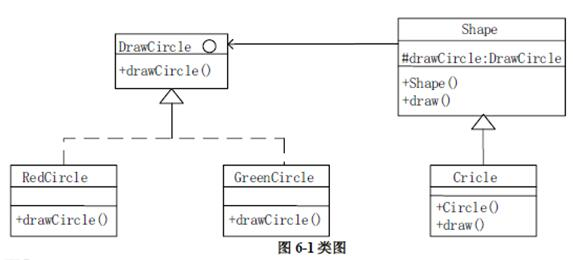设有以下类的定义:class Ex{ int x;public:void setx(int t=0);};若在类外定义成员函数setx( ),以下定义形式中正确的是A.void setx(int t){…}B.void Ex::setx(int t){…}C.Ex::void setx(int t){…}D.void Ex::setx( ){…}
题目
设有以下类的定义:
class Ex
{ int x;
public:
void setx(int t=0);
};
若在类外定义成员函数setx( ),以下定义形式中正确的是
A.void setx(int t){…}
B.void Ex::setx(int t){…}
C.Ex::void setx(int t){…}
D.void Ex::setx( ){…}
相似考题
参考答案和解析
解析:选项A可以排除,原因是类的成员函数的定义必须用域作用符::进行限定;选项C的限定位置不对,函数的类型应在最前面。根据上下文可以指导,setx为单参成员函数,在定义时也必须指定参数,因此选项D也可以排除,正确答案为B。
更多“设有以下类的定义: class Ex {int x;public:void setx(int t=0); }; 若在类外定义成员函数setx( ”相关问题
-
第1题:
设有以下函数:
voidfun(intn,char}s){……}
则下面对函数指针的定义和赋值均正确的是( )。
A.void(*pf)(int,char);pf=&fun;
B.void+pf( );pf=fun;
C.void*pf( );*pf=fun;
D.void(*pf)(int,char*);pf=fun;
正确答案:D
函数的参数可以是指针类型。它的作用是将一个变量的地址传送到另一个函数中。函数名代表函数的人口地址,指向函数的指针应该定义为void(+pf)()。如果定义为void·pf(),则表示函数pf返回值为一个基类型为void的指针。因此D选项正确。 -
第2题:
阅读以下说明和Java程序,填写程序中的空(1)~(6),将解答写入答题纸的对应栏内。
【说明】
以下Java代码实现一个简单绘图工具,绘制不同形状以及不同颜色的图形。部分接口、类及其关系如图5-1所示。


【Java代码】
interface?DrawCircle?{? //绘制圆形 public(1) ;}class?RedCircle?implements?DrawCircle?{? ?//绘制红色圆形???????public?void?drawCircle(int?radius,intx,?int?y)??{????????????System.out.println("Drawing?Circle[red,radius:"?+?radius?+",x:"?+?x?+?",y:"?+y+?"]");???????}}class?GreenCircle?implements?DrawCircle?{????//绘制绿色圆形??????public?void?drawCircle(int?radius,?int?x,int?y)?{???????????System.out.println("Drawing?Circle[green,radius:"?+radius+",x:?"?+x+?",y:?"?+y+?"]");??????}}abstract?class?Shape?{????//形状? protected? ? (2)???;? ? public?Shape(DrawCircle?drawCircle)?{? ?this.drawCircle=?drawCircle;? ? ? public?abstract?void?draw();}class?Circle?extends?Shape?{? //圆形? ?private?int?x,y,radius;? public?Circle(int?x,int?y,intradius,DrawCircle?drawCircle)?{? ?(3)???;? this.x?=?x;? ? ? this.y?=?y;? ?this.radius?=radius;? }? ? ?public?void?draw()?{? ? drawCircle.? ?(4)? ?;? ? ? }}public?class?DrawCircleMain?{? public?static?void?main(String[]?args)?{? Shape?redCircle=new?Circle(?100,100,10,? (5) );//绘制红色圆形? Shape?greenCircle=new?Circle(200,200,10,(6) );//绘制绿色圆形? ?redCircle.draw(); greenCircle.draw();? ?}}答案:解析:(1)void drawCircle (int radius,int x,int y)
(2)DrawCircle drawCircle
(3)super.drawcircle=drawcircle
(4)drawCircle(radius,x,y)
(5)new RedCircle()
(6)new GreenCircle()【解析】
第一空是填接口里面的方法,在接口的实现里面找,可以发现应该填void drawCircle (int radius,int x,int y)。
第二空可以根据后面this drawCircle=drawCircle判断,这里应该有一个drawCircle属性,因此应该填)DrawCircle drawCircle。
第三空这里用super,用super. drawcircle来引用父类的成员。
第四空调用drawCircle(radius,x,y)方法。
第五、六空分别创建一个红色圆形对象和一个绿色圆形对象作为Circle里面的实参。 -
第3题:
已知一个类Sample,()是定义指向类Sample成员函数的指针,假设类有三个公有成员: void f1(int)、void f2(int)和int a。
A.Sample *p
B.int Sample::*pc=&Sample::a
C.void (Sample:: *pa)(int)
D.Sample *a[10]
C -
第4题:
有以下程序:includeusing namespace std;class sample{private: int x;public: void 有以下程序: #include <iostream> using namespace std; class sample { private: int x; public: void setx(int i) { x=i; } int putx () { return x; } }; int main ( ) { sample *p; sample A[3]; A[0] .setx(5); A[1] .setx (6); A[2] .setx(7); for (int j=0;j<3;j++) { p=&A[j]; cout<<p->putx () <<", "; } cout<<end1; return 0; } 执行后执行结果是( )。
A.5,6,7,
B.5,5,5,
C.6,6,6,
D.7,7,7,
正确答案:A
解析:对象数组是指数组元素为对象的元素,该数组中的每一个元素都是同一个类的对象。程序中,定义了类sample的对象数组A,并调用各个对象的成员函数给其私有数据成员赋值。然后通过for循环将其值输出。 -
第5题:
阅读下列说明和C++代码,填写程序中的空(1)~(6),将解答写入答题纸的对应栏内。
【说明】
以下C++代码实现一个简单绘图工具,绘制不同形状以及不同颜色的图形。部分类及其关系如图6-1所示。

【C++代码】
#include?#include?using?namespace?std;class?DrawCircle?{??????//绘制圆形,抽象类? ? ? public: (1);//定义参数为?int?radius,?int?x,?inty? ?virtual~DrawCircle()?{?}};class?RedCircle:public?DrawCircle?{????//绘制红色圆形? ? ? ? public: void?drawCircle(intradius,?int?x,?int?y)?{cout?<?drawCircle?=?drawCircle;? }? ?virtual~shape()?{?}? public:? ?virtual?void?draw()?=?0;};class?Circle:public?Shape?{????//圆形? ? private:? ? ?int?x,y,radius;? ? public:? Circle(int?x,inty,int?radius,DrawCircle?*drawCircle)? (3)? {? this->x?=?x;? ?this->y?=?y;? ? this->radius?=?radius; }? ? ? public:? void?draw(){? drawCircle?-> (4); }};int?main(){Shape?*redCirclenew?Circle(100,100,10,????(5)????);//绘制红色圆形? Shape?*greenCircle=new?Circle(100,100,10, (6)??);//绘制绿色圆形redCircle >draw();? ?greenCircle?->draw();? ?return?0;}答案:解析:(6)(1)void drawCircle (int radius,int x,int y)
(2)DrawCircle*drawCircle
(3)drawcircle
(4)drawCircle(radius,x,y)
(5)new RedCircle()
(6)new GreenCircle()【解析】
第一空是填接口里面的方法,在接口的实现里面找,可以发现应该填void drawCircle (int radius,int x,int y)。
第二空可以根据后面this drawCircle=drawCircle判断,这里应该有一个drawCircle属性,因此应该填)DrawCircle drawCircle。
第三空这里填drawcircle,用-> drawcircle来引用父类的成员。
第四空调用drawCircle(radius,x,y)方法。
第五、六空分别创建一个红色圆形对象和一个绿色圆形对象作为Circle里面的实参。
